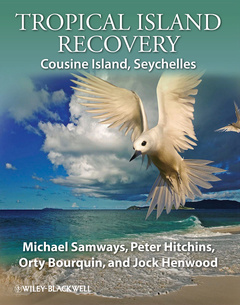Tropical Island Recovery Cousine Island, Seychelles
Auteurs : Samways Michael, Hitchins Peter, Bourquin Orty, Henwood Jock

There is no other book available on this case study. The need for the book arises from the fact that here is a positive note for conservation in these times of so much negative news on the state of our environment. More importantly, the book shows how such restoration should be done, and is therefore a model for many other islands around the world. The book has many illustrations so as to give the book wide appeal and literally to show what can done in terms of restoration. All this is based on much scientific detail, including many new data. The aim is, by way of example, to demonstrate how practical restoration, based on sound scientific research, can be carried out for the betterment of ecological integrity and ecosystem health.
Acknowledgements
Cousine Island in a world context
Cousine as a Seychelles island
Cousine Island’s conservation significance in a nutshell
How humans nearly pushed Cousine past the tipping point
The changing seasons
The lie of the land
Cousine's rocks, soils and sand
The moody sea
Cousine's green carpet
Cousine's woody cloak
Cousine's vegetation reprieve
Sponges, corals and the great bleaching event
Life in the shallow sea: from shells to urchins
Between sea and land: a variety of crabs
Ecological webmasters: terrestrial invertebrates
A rich tapestry of fish life
Cousine as a haven for turtles
Of tortoises, lizards and snakes
Overcoming the extinction of experience: sea bird haven
Aquatic and shore birds
A truly successful story: endemic land birds
The welcome and the unwelcome: vagrant and alien birds
Visiting mammals to Cousine
Cousine Island in the world today, and its future
Scientific summary
List of species recorded on and around Cousine
Glossary
Bibliography
Photographic and artwork credits
About the authors
Index
Peter Hitchins was Cousine Island Manager 1995-2001, and Conservation Advisor to the Island 2002-2004.
Orty Bourquin was Conservation Consultant to Cousine Island during instigation of the Island’s Management Plan.
Jock Henwood has been Cousine Island Manager, 2002-present.
Date de parution : 05-2010
Ouvrage de 260 p.
22.6x28.5 cm
Thème de Tropical Island Recovery :
Mots-clés :
biodiversity; tropical islands; world; trend; tropical; example; impoverishment; recovery; remarkable; island; countercurrent; degraded; highly; revitalized; seabirds; cousine; vegetation; natural; carpet; alien vertebrates
